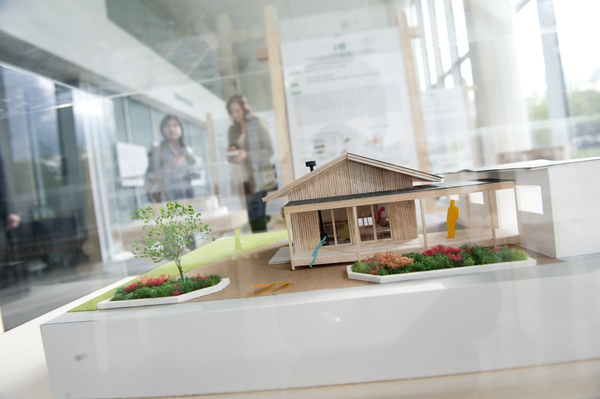Architectural lessons from Japan’s 2011 earthquake

The Great East Japan Earthquake of 2011 devastated much of the Pacific Rim nation, which faced a huge array of challenges in the aftermath including widespread relocation of citizens who lost their homes and the Fukushima nuclear disaster.
Now, Japan is sharing the lessons it learned responding to that disaster—now known to many simply by its date, 3/11—with a traveling exhibition making its sole United States stop at Northeastern. The show, “How Did Architects Respond Immediately After 3/11?—An Exhibition on the Great East Japan Earthquake,” is on display and open to the public through June 12 in the lobby of International Village.

Akira Muto, Consul General of Japan in Boston
“This is a kind of obligation, to share what we went through during and after the earthquake with the international community,” Akira Muto, the Japanese consul general to the United States stationed in Boston, said Tuesday evening at the exhibition’s opening reception. “We wanted not only to engage the experts in the field, but also the students—the young people just getting started looking at issues like this. And we hope that it sparks further collaboration between nations on these challenges that we all face.”
The exhibition, organized by the Japan Foundation, was brought to Northeastern by the Consulate General of Japan in Boston, Northeastern’s Gallery 360, the Northeastern Center for the Arts, and the College of Arts, Media and Design. A meeting last fall between Muto and Northeastern University President Joseph E. Aoun led to the university hosting the traveling exhibit.
Tuesday’s opening reception featured remarks from Muto and Xavier Costa, dean of the College of Arts, Media and Design. Costa said the exhibit is important because it shows how architects can play a crucial role in emergency preparedness and response.
“This exhibit features a strong compilation of the great challenges Japan faces and how architects can be important responders to those challenges,” Costa said.

The exhibit features work from architects in Japan and around the globe.
Japan’s location in the Pacific Ocean makes it particularly susceptible to natural disasters like earthquakes and tsunamis. As a result, the country has historically paid particular attention to disaster preparedness and resiliency, ensuring that the public is prepared through regular emergency drills and protected by infrastructure able to withstand massive disasters, said Susan Gill, who works in the consulate’s information and culture section. Though the preparations aren’t always perfect, Japan believes the lessons they have learned, particularly during and after the 2011 earthquake, are important to share with the international community.
The exhibit is split into four sections, documenting issues of emergency preparedness, temporary housing, reconstruction projects, and foreign proposals. Its curator, Taro Igarashi, Tohoku University professor of architecture and building science, said the exhibition focuses particularly on architectural advances after November 2011, showcasing projects introduced across Japan.
“What you do after a big disaster—an earthquake, a tsunami, a superstorm, or an act of terror—can be very similar even if the cause is different. Bringing this exhibit and showcasing Japan’s response provides what we hope is an opportunity for shared understanding in thinking about architecture’s role in disaster response and resiliency,” Gill said. “It fits in nicely at Northeastern, where people are thinking about these issues and generating new ideas and solutions.”




